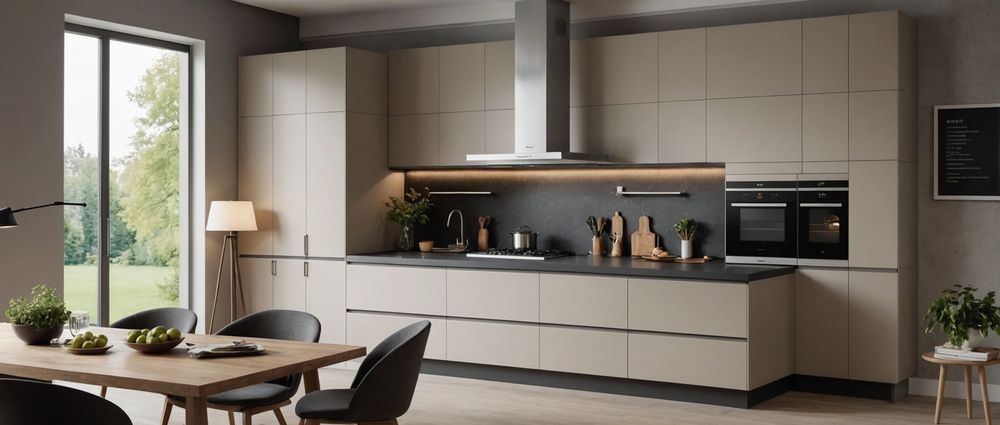A chimney, in the context of kitchen appliances, is a device that helps in the ventilation of cooking smoke, odors, and steam. Intended to improve indoor air quality, chimneys expel unwanted elements, ensuring that your kitchen remains a pleasant environment to work in. Choosing the right chimney for your kitchen involves understanding the different types available and their respective functionalities. This article delves into the various types of chimneys, their features, and how to select the best one for your cooking space.
Types of Kitchen Chimneys

Kitchen chimneys come in several styles, each designed to cater to specific needs and kitchen designs. Understanding these types can assist you in choosing the right one for your home. Here are the most common types of kitchen chimneys:
- Wall-Mounted Chimneys: These are mounted on the wall above the cooking range and are commonly used in kitchens with limited space.
- Island Chimneys: Ideal for kitchens with an island gas range, these chimneys hang from the ceiling and provide a sleek look.
- Built-in Chimneys: These are integrated into kitchen cabinetry, offering a seamless design and efficient ventilation.
- Under-Cabinet Chimneys: Mounted beneath a cabinet, these models save space and blend well with existing cabinetry.
- Downdraft Chimneys: Installed behind the cooktop, these chimneys pull smoke downwards and are often used in modern kitchens.
By recognizing these types, you can better assess which chimney will fit your kitchen’s layout and your cooking habits accurately. Each type has its own set of advantages, and their functionality could also depend on the size of your kitchen and the frequency of cooking.
Key Features to Consider
When selecting a chimney for your kitchen, certain features should be taken into account to ensure optimal performance and ease of use. Consider the following:
- Extraction Rate: Measured in cubic meters per hour (m³/h), a higher extraction rate implies better effectiveness at removing smoke and odors.
- Noise Levels: Look for models designed to operate quietly, especially if you frequently entertain guests in your kitchen.
- Cleaning Mechanism: Some chimneys come with self-cleaning features, which significantly reduce maintenance efforts.
- Filters: Check whether the chimney uses mesh or baffle filters, as this impacts the overall cleaning process and longevity.
- Design and Finish: Your chimney should complement your kitchen’s décor, so consider designs and finishes that match your existing appliances.
Taking the time to consider these features can make a significant difference in the efficiency and aesthetics of your kitchen chimney. The right features will enhance your cooking experience and help maintain the cleanliness of your kitchen space.
Installation Considerations

Proper installation is crucial for a kitchen chimney to function efficiently. Ensure that it is installed by a professional to avoid any issues related to vent placement or duct size. Here are some installation considerations to keep in mind:
- Positioning: The chimney should be installed at the recommended height above the cooktop to effectively capture rising smoke and steam.
- Ducting: Consider whether to go for ducted or ductless installation, with ducted options generally preferred for better extraction.
- Power Supply: Ensure there’s a nearby electrical outlet to power the chimney, ideally away from water sources.
- Space: Verify that the kitchen has enough space to accommodate the installation without compromising movement.
- Compliance: Check local building codes or manufacturer specifications to ensure compliance with safety standards.
Addressing these aspects during installation helps in optimizing the performance of your kitchen chimney and prevents extra costs due to inefficient setups later.
Conclusion
Choosing the right chimney for your kitchen is essential not only for effective ventilation but also for enhancing the overall cooking experience. By understanding the different types of chimneys available, considering key features, and paying attention to installation requirements, you can make an informed choice. Invest in a chimney that meets your specific needs, suits your kitchen design, and operates efficiently to maintain a fresh cooking environment. With optimal care and maintenance, a well-chosen chimney can serve you for years to come.
FAQs
1. What is the main function of a kitchen chimney?
The main function of a kitchen chimney is to vent out smoke, odors, and grease from the cooking area, thereby maintaining a cleaner and fresher environment in your kitchen.
2. How do I determine the right chimney size for my kitchen?
The size of your kitchen and the type of cooking you do will dictate the chimney’s size. A general guideline is to choose a chimney that provides 10 to 15 air changes per hour.
3. Are chimney filters easy to clean and replace?
Most chimneys come with washable or replaceable filters. Mesh filters require more frequent cleaning, while baffle filters are generally more durable and easier to maintain.
4. Can I install a chimney myself, or should I hire a professional?
While some homeowners choose DIY installation, it’s recommended to hire a professional to ensure proper setup and compliance with safety standards.
5. Do kitchen chimneys consume a lot of electricity?
Kitchen chimneys typically consume moderate amounts of electricity. The overall power usage will depend on the model’s design, motor efficiency, and frequency of use.


